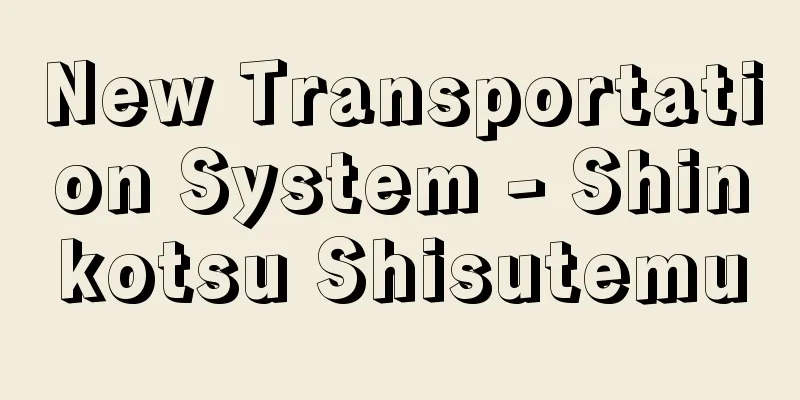New Transportation System - Shinkotsu Shisutemu

|
While conventional general railways run on steel rails with iron wheels, AGTs are public transportation systems that run on dedicated tracks with rubber tires. In a broad sense, it can be taken to include various types of transportation systems that have been created through recent technological developments, but in a narrow sense, it refers to railways that run on guide rails with rubber tires, such as the Yurikamome (Tokyo Waterfront New Transit Waterfront Line) that runs through Tokyo's waterfront area, the Nanko Port Town Line (New Tram) in Osaka, and the Port Island Line (Kobe New Transit) in Kobe. Under Japanese regulations (Railway Business Act, etc.), adhesion-type railways such as JR and general private railways are called ordinary railways, and railways such as AGTs that run on dedicated tracks with rubber tires and guide rails are called automated guideway transit (AGT). The APT system has a transport capacity of around 5,000 to 15,000 people per hour, which is more than that of buses but less than that of high-speed rail, and is considered a medium-capacity means of transport. [Yoshikawa Fumio] HistoryThe new transit system is said to have started with the suggestions made in the 1968 US government report "Tomorrow's Transportation," which considered the new construction of urban transportation systems. Four types of new transit systems were exhibited at the 1972 Transpo '72 transportation exposition held in Washington DC, the nation's capital, and two years later, in 1974, the new transit system AirTrans opened as an airport shuttle at Dallas-Fort Worth Airport in Texas. This was followed in 1975 by a new transit system called Personal Rapid Transit (PRT) in the university town of Morgantown, West Virginia, for students traveling between campuses at West Virginia University. In Japan in the 1970s, as research and development was promoted by the Ministry of International Trade and Industry (now the Ministry of Economy, Trade and Industry) and the Ministry of Construction (now the Ministry of Land, Infrastructure, Transport and Tourism), various manufacturers began to develop prototypes, and at the International Ocean Expo held in Okinawa in 1975, KRT (Kobe Rapid Transit), a company formed by Kobe Steel, Kobelco Electric and other companies, and CVS (Computer Controlled Vehicle System) of the Mechanical Systems Foundation transported passengers for a limited period only during the exposition. In addition, VONA (Vehicles of New Age), developed by Nippon Sharyo and others, ran in Yatsu Amusement Park along the Keisei Electric Railway line in 1972 (discontinued when Yatsu Amusement Park was closed in 1982). The first permanent transportation system was the Kobe New Transit Port Island Line, which opened in February 1981. It was a 6.4 km route that ran from Kobe's downtown Sannomiya to the artificial island of Kobe Port, and was used to get to the Portopia '81 Expo site, which was held at the time. After that, the New Tram opened in Osaka City in March 1981, the Yamaman Yukarigaoka Line in Chiba Prefecture in November 1982, Saitama New Urban Transit in December 1983, the Kobe New Transit Rokko Island Line in February 1990, the Tokadai New Transit in Aichi Prefecture in March 1991 (discontinued in October 2006), the Yurikamome in November 1995, and the Nippori-Toneri Liner in March 2008. Currently, many new transport systems around the world are operated as medium-capacity transport in cities and as transport within large airports. New structures and methods are being developed one after another, and this trend is expected to continue in the future. [Yoshikawa Fumio] Guide rail mechanismAmong the various types of new transportation systems, I would like to focus on the guideway mechanism, which has many practical applications. Guide rail type trains run on a concave concrete track with rubber tires, but there are separate guide wheels that are guided by guide rails. Depending on the arrangement of the guide rails, they can be divided into side guide type, which is located on the side, and central guide type, which is located in the center. In Japan, side guide type is more common, and is used by Kobe New Transit, Yurikamome, and Osaka City's New Tram. The central guide type is used by the Yamaman Yukarigaoka Line in Chiba Prefecture. In the side guide type, the guide wheels are guided by movable guide plates installed on the track and move in the specified direction, so there are no branching points like those found on steel rails. The vehicles are operated by connecting small two-axle cars, but the wheels are not bound to the body and can generally be steered like the front wheels of a car. The trains are powered by electricity, but instead of overhead lines, small current collectors collect electricity from the electric wires on the side of the tracks, and the motor drives the wheels. Standard voltage is 750V DC or 600V three-phase AC. Trains are either unmanned by an Automatic Train Operation (ATO) system or operated by a single driver. Even unmanned trains have a driver's cab in case of an emergency, but it is normally covered. There are dual systems for driving control, including braking, and the system is set up to ensure safety even if one system has a problem. These operations are often managed by a computer in a central control center, which monitors the operating status of the train, including station announcements and platform doors. [Yoshikawa Fumio] New transportation system in a broad senseAmong the methods that are broadly regarded as new transportation systems, the main ones are introduced below. [Yoshikawa Fumio] Suspended monorailIt has a structure that can be called a monorail similar to a ropeway, with the running wheels and guide wheels running on a steel track girder, and in the middle, the train grabs a rope stretched across the track girder to run, and when it departs from a station or stops, it accelerates or decelerates using the electromagnetic force of a coil installed on the ground called a reaction plate. Therefore, the train is not powered, and the rope is moved by the rotation of a pulley on the ground. Hiroshima City's Skyrail Service uses this method. [Yoshikawa Fumio] Guideway BusA bus that runs on a dedicated track (guideway) using a guidance device, with guide wheels attached to the vehicle. This means that the driver does not need to operate the steering wheel. At first glance, the vehicle looks no different from a bus, but it is included in the category of internal combustion (diesel engine) guideway railways. It can operate not only on dedicated tracks, but also on general roads. It opened in Nagoya City in March 2001 as the Nagoya Guideway Bus (Yutorito Line). [Yoshikawa Fumio] Air-floating, rope-towedThe power supplied to the vehicle rotates a fan that blows air from the bottom of the vehicle to make it float, and the vehicle is pulled by a rope and guided by a guide rail installed on one side of the vehicle. It runs as a shuttle system connecting the main building and satellite in the second passenger terminal building of Narita International Airport. [Yoshikawa Fumio] Magnetic Belt SystemThe magnet-attached flat belt rotates and attracts the magnets attached to the carriages. It was once operated at the International Garden and Greenery Exposition held in Osaka in 1990, and in 2001, a monorail with a similar system was operated as the Shuttle Katsuradai, a transportation system linking Saruhashi Station on the Chuo Main Line (Otsuki City, Yamanashi Prefecture) with a housing complex (discontinued in 2007). Other than this, overseas trials are being conducted on catenary-less tire trams, which run on rubber tires and have electric wires buried under the road surface, and guided rubber tire trams, which run on rubber tires and are clamped diagonally from above along guide rails installed on the road. As environmental issues are now being given great attention in relation to urban road transport, it is expected that various new public transport methods to replace internal combustion power will be considered. [Yoshikawa Fumio] Current situation in JapanNew transportation systems under the jurisdiction of the Ministry of Land, Infrastructure, Transport and Tourism's railway business include the Yamaman Yukarigaoka Line, Saitama New Urban Transit, Seibu Railway Yamaguchi Line, Yurikamome, Yokohama New Urban Transit, Osaka City Nanko Port Town Line, Kobe New Transit, Hiroshima Rapid Transit, Skyrail Service, and Nagoya Guideway Bus. Of these, all but the Skyrail Service and the Yutorito Line are electrically powered guideway railways with rubber-tired wheels. Looking at new transit systems as business entities, they are characterized by the fact that many of them are third-sector entities jointly funded by prefectures, cities, and other local governments, local businesses, and financial institutions. One unique example is the Yukarigaoka Line, run by Yamaman Co., Ltd., which was built by a land developer as transportation for residential areas. Another notable feature of this line is that the entire system has been simplified in an effort to reduce costs. Tokyo's Yurikamome Line has the highest passenger numbers, with an average of 98,000 passengers per day (2010), and is popular as a form of transportation in Tokyo's waterfront area due to the excellent views it offers from the train windows. The Tokadai New Transit service, which was abolished in 2006, had a unique way of running. The terminal station was a loop line, and the cars did not turn around, but instead went around the loop once and changed direction. For this reason, the regular driver's cab was only in the front car, and the passenger doors were on one side, like those on a bus. [Yoshikawa Fumio] "New Transportation Systems" by Yoshikawa Fumio (1990, Hoikusha)" ▽ "Creating a New Transportation System" by Saima Toru (1994, Chikuma Shobo)" ▽ "The Formation of Local Communities and Transportation Policies" edited by Ishizaka Yoshio and Watanabe Yoshiro (1997, Toyokan Publishing)" ▽ "New Urban Transportation Systems" by the Urban Transportation Research Group (1997, Sankaido) The Tokyo Waterfront New Transit Waterfront Line connects Shinbashi (Minato Ward) and Toyosu (Koto Ward). It is an unmanned train controlled by computer, and travels 16 stations and 14.7 km in 31 minutes. It uses a side guide system and has six carriages. It carries an average of 86,000 passengers per day. Opened in 1995 (Heisei 7) ©Yutaka Sakano "> Yurikamome A new transportation system that connects Hondori Station (Kamiyacho, Naka Ward) and Koiki Koenmae Station (Otsuka Nishi, Asaminami Ward) in 35 minutes, covering a distance of about 18 km. It began operation in 1994. It is a guide rail railway with rubber tires, and each train consists of six cars. The average speed is 30 km/h (maximum speed 60 km/h). Hiroshima City, Hiroshima Prefecture © Hiroshi Aizawa "> Hiroshima Rapid Transit (Astram Line) Source: Shogakukan Encyclopedia Nipponica About Encyclopedia Nipponica Information | Legend |
|
在来の一般の鉄道が、鋼鉄製のレールの上を鉄の車輪によって走行する方式であるのに対し、新交通システムは、ゴムタイヤ車輪によって専用軌道を走行する公共交通機関である。広義には最近の新技術開発によって誕生した種々の方式の交通システムを包含してとらえる場合もあるが、狭義には、日本でいうと東京の臨海地区を走っている「ゆりかもめ」(東京臨海新交通臨海線)や大阪市の「南港ポートタウン線」(ニュートラム)、神戸市の「ポートアイランド線」(神戸新交通)のように、ゴムタイヤ車輪によって案内レールに沿って走行する方式の鉄道をさしている。日本の法規上(鉄道事業法など)ではJRや一般の私鉄のような粘着方式の鉄道を普通鉄道、ゴムタイヤ車輪と案内レールによって専用軌道を走行する新交通システムのような鉄道を案内軌条式鉄道automated guideway transit(AGT)としている。 新交通システムの輸送力は1時間当り5000~1万5000人くらいであり、バスよりは多く、高速鉄道よりは少ない、中量輸送機関としてとらえられている。 [吉川文夫] 沿革新交通システムは都市交通システムの新しい構築を考えたアメリカ政府の1968年の報告書「Tomorrow's Transportation(明日の輸送)」での指摘に始まるとされている。1972年首都ワシントンDCで開催された交通博覧会トランスポ'72で4種類の新交通システムが出展され、その2年後の1974年にテキサス州ダラス・フォートワース空港の空港内連絡輸送機関として新交通システム、エアトランスが開通した。続いて1975年にはウェスト・バーニジア州の学園都市モルガンタウンにおいて、ウェスト・バージニア大学のキャンパス間を移動する学生のため、パーソナル・ラピッド・トランジットPersonal Rapid Transit(PRT)と称する新交通システムが開通した。 日本では1970年代通商産業省(現、経済産業省)、建設省(現、国土交通省)で研究開発が推進されるなか各メーカーが試作開発に乗り出し、1975年(昭和50)に沖縄で開催された国際海洋博覧会で神戸製鋼所、神鋼電機などのグループによるKRT(Kobe Rapid Transit)と、財団法人機械システム振興協会のCVS(Computer Controlled Vehicle System)が、博覧会の開催期間中という限定した期間であるが、乗客輸送を行った。このほか、遊園地の遊戯施設としてではあるが日本車輛(しゃりょう)製造などが開発したVONA(ボナ)(Vehicles of New Age)が京成電鉄沿線の谷津(やつ)遊園内で1972年に走っている(1982年谷津遊園廃止に伴い廃止)。 恒久的輸送機関としての最初は1981年2月に開業した神戸新交通のポートアイランド線で神戸の繁華街三宮(さんのみや)から神戸港の人工島を一回りする営業キロ6.4キロメートルの路線で、おりから開催された博覧会ポートピア'81の会場への足として活躍した。その後、1981年3月に大阪市でニュートラム、1982年11月に千葉県で山万ユーカリが丘線、1983年12月に埼玉新都市交通、1990年(平成2)2月に神戸新交通六甲アイランド線、1991年3月に愛知県で桃花台(とうかだい)新交通(2006年10月廃止)、1995年11月に「ゆりかもめ」、2008年3月日暮里・舎人(とねり)ライナーなどがそれぞれ開業している。 現在世界的にみると新交通システムは都市の中量輸送機関と大きな空港の空港内連絡輸送機関として運行されているものが多い。そしてその構造、方式については新しい方式のものが続々と誕生してきており、この流れは今後も続くものと思われる。 [吉川文夫] 案内軌条式のメカニズム種々の方式がある新交通システムのうち、実用例の多い案内軌条式のメカニズムについて触れておきたい。 案内軌条式はコンクリート製の凹形をした軌道をゴムタイヤの車輪によって走行するが、走行車輪とは別に案内用の車輪があり、これが案内レールによってガイドされて走る。この案内レールの配置によって、側面にある側方案内方式と中央にある中央案内方式に分けられる。日本では側方案内方式が多く、神戸新交通、ゆりかもめ、大阪市のニュートラムなどが採用している。中央案内方式は千葉県の山万ユーカリが丘線が採用している。一般の鉄道でいうポイント、線路の分岐は側方案内方式では案内車輪が軌道に設けられた可動案内板によってガイドされて所定の進路方向に進むので、軌道を見ても鉄レールのポイントのような分岐部は見当たらない。車両は小型の2軸車を連結して運転しているが、車輪は車体に拘束されておらず、自動車の前輪のようにステアリング(ハンドル操作)できるのが一般的である。 走るための動力は電気であるが、架空電車線はなく、軌道の側面に設けられた電車線から小型の集電装置で集電してモーターによって車輪を駆動している。電圧は直流750ボルトか三相交流600ボルトが標準である。列車の運転は自動列車運転装置(ATO)による無人運転かワンマン運転である。無人運転の車両でも異常時などに備えて運転台を設備しているが、通常時はカバーで覆われている。ブレーキを含めた運転制御は二重系としており、一系統がトラブルをおこしても安全であるようにシステムが組まれている。これらの運行管理は、駅の案内放送およびホームドアも含めて中央指令所のコンピュータで列車の運転状態などを監視しながら制御されていることが多い。 [吉川文夫] 広義の新交通システム広い意味での新交通システムとしてとらえられている方式のうち、おもなものを次に紹介する。 [吉川文夫] 懸垂式モノレールロープウェーに近いモノレールといえる構造で、鋼製の軌道桁(けた)に走行輪と案内輪が接して走るが、中間部では軌道桁に張られたロープをつかんで走行、駅から出発するとき、停車するときはリアクションプレートという地上側に設けられたコイルの電磁力により加速、減速する方式である。したがって車両には動力はなく、ロープは地上の滑車の回転により動いている。広島市のスカイレールサービスがこの方式である。 [吉川文夫] ガイドウェーバス専用の走行路(ガイドウェー)を案内装置によって走行するバスで、案内輪を車両に取り付けている。このため運転士はハンドル操作を必要としない。車両は一見、バスと変わらないが、内燃動力(ディーゼルエンジン)の案内軌条式鉄道に含まれている。専用の走行路だけでなく、一般道路での運行が可能。2001年3月に名古屋市内に名古屋ガイドウェイバス(ゆとりーとライン)として開業している。 [吉川文夫] 空気浮上・ロープ牽引式車両に供給された電源で送風機を回転させ、車両の底部から空気を吹き出して浮上させ、この車両をロープで引っ張って走行させる方式で、車両の片方に設置された案内レールでガイドされる。成田国際空港第2旅客ターミナルビル内の本館とサテライトを結ぶシャトルシステムとして走っている。 [吉川文夫] 磁気ベルト式システム磁石を取り付けた平ベルトを回転させ、車両に取り付けた磁石を吸着走行するものである。1990年大阪で開催された国際花と緑の博覧会で運転されたことがあったが、2001年これと近い方式のモノレールが中央本線猿橋駅(山梨県大月市)と住宅団地を結ぶ交通システム、シャトル桂台として運行していた(2007年廃止)。 このほか海外では電車線を路面に埋設設置しゴムタイヤ車輪で走る架線レスタイヤトラムや、道路に設置されたガイドレールを斜め上から挟み、ゴムタイヤ車輪で走行するガイドゴムタイヤトラムなどが試行実験されている。都市路面交通については環境問題が大きく取り上げられている時期なので、内燃動力にかわる新しい公共交通が各種検討されるようになると思われる。 [吉川文夫] 日本の現状国土交通省の鉄道事業の所管にある新交通システムでは、山万ユーカリが丘線、埼玉新都市交通、西武鉄道山口線、ゆりかもめ、横浜新都市交通、大阪市南港ポートタウン線、神戸新交通、広島高速交通、スカイレールサービス、名古屋ガイドウェイバスなどがある。 このなかでスカイレールサービスとゆとりーとライン以外は電気動力によるゴムタイヤ車輪の案内軌条式鉄道となっている。新交通システムは企業体としてみると県や市などの地方自治体が地元企業、金融機関などと共同出資した第三セクターが多いのが特徴である。特異な例としては土地開発事業者が住宅地の足として敷設した山万株式会社のユーカリが丘線がある。この線はコスト低減を意図してシステム全体が簡易にまとめられていることにも特徴がある。 輸送人員の多い東京の「ゆりかもめ」は1日平均利用者数が9万8000人(2010年度)で、東京臨海地区の輸送機関として車窓からの眺めもよいことから人気を博している。 2006年に廃止となった桃花台新交通は、走行方法がユニークであった。終端駅がループ線になっていて、車両は折り返すことなく、ループを一回りして方向を転換し、このため正規の運転台は先頭車にしかなく、客用扉もバス並みに片側であった。 [吉川文夫] 『吉川文夫著『新交通システム』(1990・保育社)』▽『斎間亨著『新交通システムをつくる』(1994・筑摩書房)』▽『石坂悦男・渡部与四郎編著『地域社会の形成と交通政策』(1997・東洋館出版社)』▽『都市交通研究会著『新しい都市交通システム』(1997・山海堂)』 新橋(港区)―豊洲(江東区)を結ぶ東京臨海新交通臨海線。コンピュータ制御による無人運転で、16駅14.7kmを31分で運行する。側方案内方式を採用し、車両編成は6両。1日平均約8万6000人の乗客が利用する。1995年(平成7)開業©Yutaka Sakano"> ゆりかもめ 本通駅(中区紙屋町)―広域公園前駅(安佐南区大塚西)間約18kmを35分で結ぶ新交通システム。1994年(平成6)に営業を開始した。ゴムタイヤ車輪の案内軌条式鉄道で、1編成6両。表定速度30km/h(最高速度60km/h)。広島県広島市©相澤 弘"> 広島高速交通(アストラムライン) 出典 小学館 日本大百科全書(ニッポニカ)日本大百科全書(ニッポニカ)について 情報 | 凡例 |
Recommend
Engineering mechanics
… In the second half of the 19th century, the bas...
Amor Fati - Amor Fati
…Modern people may find this coexistence of fate ...
Moose (Alces alces)
Also known as the moose. In North America it is ca...
baja danza (English spelling) bajadanza
…Though the origins of dance in Spain are very ol...
Vifredo (English spelling)
?-898 The founder of early Catalonia. In Catalan, ...
Belyi gorod (English spelling)
…Even in the Soviet era, May Day and Revolution D...
Lowry, TM
…In the 20th century, more unified concepts emerg...
impara lily
...The flowers grow in clusters after new shoots ...
Cho Bansik - Soubanshoku
Korean nationalist leader. His pen name was Kodo....
Beard, GM (English spelling) BeardGM
…This concept was proposed by American neurologis...
Lack of a ball - Kyuketsu
→ Ball crown Source : Heibonsha Encyclopedia About...
Tada Nanrei - Just Nanrei
Year of death: 12 September 1750 (11 October 1750)...
Katsumotoura
…On the other hand, the coast surrounding the isl...
Osaka Women's Music School
...Private music schools were the Women's Mus...
Shuvalov, PI (English spelling) ShuvalovPI
…Under the Empress, the salon culture and the Eur...



![Nagi [town] - Nagi](/upload/images/67cc654d7096b.webp)





